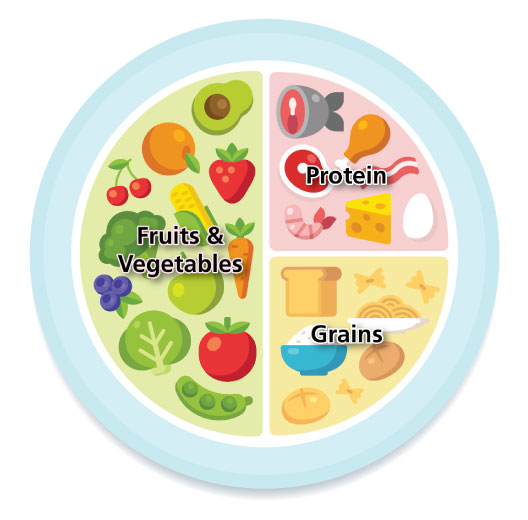Thanks to the advancement of technology in food production, we have a large array of food types for our daily consumption. With the variety of food available today, ensuring the right food selection poses a challenge, as the practice to consume nutrient-dense food is still relatively low in Malaysia. According to research on Malaysian’s dietary intakes in 2019, the Malaysian diet is relatively energy-dense and nutrient-poor1.
Consuming energy-dense food — in other words, calorie-dense food — has proven to result in common adverse effects namely overweight and obesity. However, research conducted locally among urban Malaysian children in 2016 found that a high calorie-dense diet correlates to stunting2.
In a typical Malaysian household, it is very common for a child to be fed five times a day. Parents may think that the usual number of servings is sufficient, in reality, it might not be the same for the nutrient intake, as calorie-dense food usually does not contain the proper amount of essential nutrients to support growth. Parents might need to consider swapping these high-calorie foods with better choices — for example, fast food burgers vs. sandwiches, ice-cream vs. plain yoghurt with cut fruits, sweet candies vs. fresh fruits, flavoured milk vs. formulated milk and fried vegetables vs. steamed vegetables. That said, nutrient-dense food is pivotal for children’s growth, as they need the right fuel to grow, learn and develop. Lacking the right nutrients, children in Malaysia are at risk of being stunted, and unlike gaining weight, stunting is irreversible.
Nutrient-dense food is defined as foods that are rich in vitamins, minerals and other nutrients important for health and growth, without an excessive amount of saturated fat, added sugars and sodium. Additionally, nutrition plays a more dominant role which determines 80% of the children’s height3, therefore, debunking the common perception that height is not just exclusively influenced by genetics. Though grocery shopping is restricted due to the lockdown, it is best to encourage a diet with a nutrient-dense selection amongst children to ensure they reach their full potential for optimal growth.
Making sure the children’s growth is on track is not just solely on nutrient-dense food consumption, as active growth tracking is also crucial to help minimise risks and identify problems at an early age. Growth issues detection by parents usually happens when the children first enter school — this is when parents get to compare their children’s height with other children. The reality is, growth issues commence at earlier stages, therefore, it is important to monitor and track their children’s growth as early and as frequently as possible.
These key steps — nutrient-dense food consumption and growth tracking, are vital to help combat the nationwide stunting phenomenon in Malaysia. The National Health and Morbidity Survey 2019 reported that 1 in 5 Malaysian children under the age of five is stunted4, and the South East Asian Nutrition Surveys (SEANUTS) revealed that most of the children in Malaysia fulfilled the Malaysian Recommended Nutrient Intake (RNI) for energy and protein, however, 1 out of 2 of them did not achieve the Recommended Nutrient Intake (RNI) for Calcium and Vitamin D5.
These findings have proven that nutrient needs tend to be parallel with the rate of growth. In order to ensure sufficient nutrients, a child’s diet must consist of all food categories including fruits, vegetables, lean meats, fish, whole grains, dairy, legumes and nuts. However, by supplementing with nutrient-dense foods, these deficiencies can be addressed. Amongst the vast nutrient-dense food out there, nutrient-dense milk plays a significant role to nourish children with proper nutrition and provide convenience for parents as a glass of nutrient-dense milk has more calcium, potassium, phosphorus and vitamins and all other nutrients required for a child’s optimal growth and development.
As parents, it is necessary to put these practices — nutrient-dense diet and consistent growth tracking — at an early stage to establish habits, in the interest to help their children reach their full growth potential.
References:
1Body Weight Status and Dietary Intakes of Urban Malay Primary School Children: Evidence from the Family Diet Study, 2017
https://doi.org/10.3390/children4010005
2Higher Dietary Energy Density is Associated with Stunting but not Overweight and Obesity in a Sample of Urban Malaysian Children
https://www.tandfonline.com/doi/abs/10.1080/03670244.2016.1181065
3Jelenkovic, A. et al. Genetic and environmental influences on height from infancy to early adulthood: An individual-based pooled analysis of 45 twin cohorts. Sci. Rep. 6, 28496; doi: 10. 1038/srep28496 (2016)
4National Morbidity Survey 2019
http://www.iku.gov.my/nhms-2019
5Nutritional status and dietary intakes of children aged 6 months to 12 years: findings of the Nutrition Survey of Malaysian Children (SEANUTS Malaysia)
https://pdfs.semanticscholar.org/05bb/4de1e68096ef84fcac60083a57b5ad6867cb.pdf?_ga=2.115456070.1595186782.1606355175-1976471054.1606355175

Corporate Nutritionist of DUTCH LADY Malaysia



